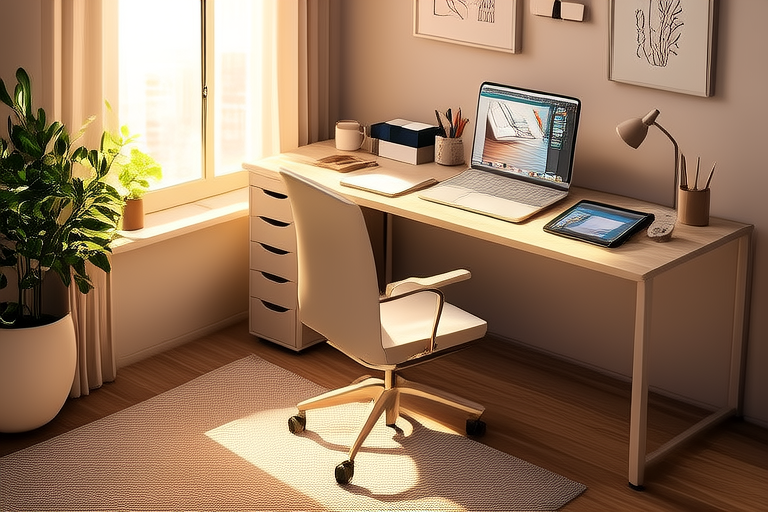Streamline Your Workflow: Ultimate Guide to Organizing Your Workspace for Creatives
Introduction
For creatives, the workspace is more than just a place to work; it’s an extension of your creative process. A well-organized and efficient workspace can significantly enhance productivity, reduce stress, and inspire creativity. Whether you’re a graphic designer, writer, or artist, having a clutter-free and ergonomically designed space can make all the difference in your daily workflow. In this ultimate guide, we’ll explore how to optimize your workspace to maximize creativity and efficiency.
The Importance of Workspace Organization
Why a Clean Desk Equals a Clear Mind
One of the most significant benefits of an organized workspace is the mental clarity it provides. When your desk is cluttered with papers, tools, and unfinished projects, it can be overwhelming and distracting. Studies have shown that a clean desk leads to better focus and higher productivity. By decluttering your workspace, you create a physical environment that reflects a clear mind, allowing you to concentrate on the task at hand.
Ergonomics for Comfort and Health
Ergonomics plays a crucial role in maintaining long-term health and comfort. Poor posture and repetitive strain injuries (RSIs) are common issues faced by creatives who spend extended periods working at their desks. Investing in ergonomic furniture, such as adjustable chairs and standing desks, can help prevent these issues. Additionally, proper lighting and positioning of monitors can reduce eye strain and fatigue, ensuring you stay productive throughout the day.
Essential Tools and Equipment
The Right Furniture for Creatives
Choosing the right furniture is essential for any creative workspace. An adjustable desk allows you to switch between sitting and standing positions, promoting better posture and reducing the risk of RSIs. A comfortable chair with lumbar support is equally important. Look for chairs that offer adjustable height, armrests, and backrests to ensure optimal comfort during long hours of work.
Technology That Enhances Creativity
Technology can be both a blessing and a curse when it comes to creative work. It’s essential to strike a balance between using the right tools and avoiding distractions. For graphic designers, software like Adobe Creative Suite is indispensable. Writers may benefit from tools like Grammarly or Scrivener to streamline their writing process. Additionally, consider using cloud storage solutions like Google Drive or Dropbox to keep your files accessible and backed up.
Organizational Strategies
Creating Zones for Different Tasks
Dividing your workspace into different zones can help you stay focused and efficient. For example, you might designate one area for brainstorming and ideation, another for detailed work, and a third for reviewing and editing. This separation not only helps in organizing your physical space but also in mentally transitioning between tasks. Consider using labels or color-coded systems to distinguish between different zones.
Managing Digital Clutter
Just as physical clutter can be distracting, so can digital clutter. Regularly cleaning up your computer desktop and organizing files into folders can save time and reduce stress. Use naming conventions that make sense to you, and consider using tags or metadata to further categorize your files. Tools like Trello or Asana can also help manage digital projects and tasks, keeping everything organized and accessible.
Practical Tips and Case Studies
Real-Life Example: The Artist’s Studio
Imagine Sarah, a freelance illustrator, whose studio was once filled with scattered art supplies and half-finished projects. After implementing some organizational strategies, she now has a designated area for her drawing table, shelves for neatly arranged art supplies, and a filing system for completed projects. This change not only improved her productivity but also reduced the stress of constantly searching for materials. She even found more time to experiment with new techniques, leading to a surge in creativity.
Step-by-Step Guide to Setting Up Your Workspace
- Assess Your Needs: Start by identifying the specific tasks you perform and the tools you need for each. This will help you determine the layout and necessary equipment.
- Declutter: Remove any unnecessary items from your workspace. Donate or recycle items you no longer use, and find homes for frequently used items.
- Organize: Invest in storage solutions like drawers, shelves, and bins to keep your workspace tidy. Label everything clearly to avoid confusion.
- Ergonomics: Ensure your workspace is ergonomically sound by adjusting your chair, desk, and monitor to promote good posture and comfort.
- Regular Maintenance: Make it a habit to regularly review and reorganize your workspace. This ensures that it remains functional and inspiring.
Conclusion
In conclusion, optimizing your workspace is key to enhancing creativity and productivity. By focusing on decluttering, ergonomics, and effective organization, you can create an environment that supports your creative process. Remember, a well-organized workspace is not just about aesthetics; it’s about creating a space that works for you.
Actionable Advice
Take the first step today by assessing your current workspace and identifying areas for improvement. Start small—perhaps by decluttering your desk or setting up a new storage solution—and gradually build upon these changes. With consistent effort, you’ll soon notice a significant boost in both your productivity and creativity.
